Dave’s Favorite First Published Science Fiction Stories: For me, there were two big weaknesses of “First Voyages” (See my review at this blog). First, because it was “Science Fiction’s Greatest Writers”, that led to the omission of some amazing first stories. Second, due to the omission of any works after 1962(!!!), a number of authors were omitted, not even considering what has been published in the last 41 years. Here is a look at what I would have included in my Favorite First Published SF stories, sorted by my rating:
- “Scanners Live in Vain”, a Instrumentality of Mankind novelette by Cordwainer Smith from Fantasy Book, Vol. 1, No. 6, January 1951 (included in “First Voyages”). Rated 4.9/5.
- “E for Effort”, a 1947 novelette by T. L. Sherrerd, May 1947 Astounding. Rated 4.8/5.
- “In Hiding”, Wilmar H. Shiras, a November 1948 Astounding novelette. Rated 4.8/5.
- “Shambleau”, C. L. Moore, a 1933 novelette in Weird Tales. Rated 4.6/5.
- “Black Destroyer”, a novelette by A. E. van Vogt, Astounding Science-Fiction, July 1939 (included in “First Voyages”). Rated 4/5.
- “Bircher”, a novelette by A. A. Walde (Warren Bertil Lindgren), If, July 1966. Rated 4.4/5.
- “Ender’s Game”, Orson Scott Card, a novelette from Analog August 1977. Rated 4.4/5.
- “Tower of Babylon”, Ted Chiang, Omni November 1990. Rated 4.3/5.
- “That Only A Mother”, a short story by Judith Merril in Astounding Science Fiction, June 1948 (included in “First Voyages”). Rated 4.1/5.
- “Angel’s Egg”, a novelette by Edgar Pangborn, Galaxy June 1951 (included in “First Voyages”). Rated 3.9/5.
- “T”, a 1956 short story by Brian W. Aldiss, Nebula Science Fiction, Number 18 (Included in “First Voyages”). Rated 3.9/5.
- “Prima Belladonna”, a 1956 Vermilion Sands short story by J. G. Ballard, Science Fantasy, v 7 #20 (Included in “First Voyages”). Rated 3.9/5.
- “Turn off the Sky”, a Ray Nelson, novelette, The Magazine of Fantasy and Science Fiction, August 1963. Rated 3.9/5.
- “Traveler’s Rest”, a David I. Masson 1965 short story, New Worlds SF, September 1965. Rated 3.9/5.
- “Life-Line”, a 1939 Future History short story by Robert A. Heinlein, Astounding Science-Fiction, August 1939 (included in “First Voyages”). Rated 3.8/5.
- “Proof”, a 1942 short story by Hal Clement, Astounding Science-Fiction, June 1942 (Included in “First Voyages”). Rated 3.8/5.
- “Come On, Wagon!”, a 1951 short story by Zenna Henderson in The Magazine of Fantasy and Science Fiction, December 1951 (Included in “First Voyages”). Rated 3.7/5.
- “My Boy Friend’s Name Is Jello”, a short story by Avram Davidson, in The Magazine of Fantasy and Science Fiction, July 1954 (included in “First Voyages”). Rated 3.7/5.
- “Walk to the World”, a short story by Algis Budrys, in Space Science Fiction, November 1952 (included in “First Voyages”). Rated 3.7/5.
- “Beyond Lies the Wub”, a Philip K. Dick short story, in the July 1952 Planet Stories (included in “First Voyages”). Rated 3.7/5.
- “Dune Roller”, a novelette by Julian May, December 1951 Astounding. Rated 3.7
- “Defense Mechanism”, a short story by Katherine MacLean, in Astounding Science Fiction, October 1949 (included in “First Voyages”). Rated 3.6/5.
- “Ether Breather”, a short story by Theodore Sturgeon, from Astounding Science-Fiction, September 1939 (included in “First Voyages”). Rated 3.5/5.
- “Loophole”, a short story by Arthur C. Clarke 4/1/2022 from Astounding Science Fiction, April 1946 (included in “First Voyages”). Rated 3.5/5.
- “Time and Time Again”, a short story by H. Beam Piper, from Astounding Science Fiction April 1947. Rated 3.5/5.
- “Anita”, a Keith Roberts short story, Science Fantasy, September-October 1964. Rated 3.5.
- “Antiquities”, a short story by John Crowley, first appeared in the anthology Whispers: An Anthology of Fantasy and Horror (August 1977, Doubleday), edited by Stuart David Schiff. Rated 3.5/5.
- “A Subway Named Mobius”, by A. J. Deutsch, Astounding December 1950. Rated 3.8/5.
As much as I have mixed feelings about “First Voyages”, I have included 15 of the 20 stories from it in my 28 Favorite First SF Stories. While I still really wonder about a few of the stories included, I do have to give the editors credit and also thank Michael Main and the “First Voyages” editors for introducing me to a number of great first SF stories.
Looking at the following chronologic Detailed Reviews/Comments, there are only two stories from the 1970s, none from the 1980s, and one from 1990 (my last entry is Ted Chiang’s amazing “Tower of Babylon” from 1990). I am sure that there have been amazing first stories released after that that I just don’t know. I’m hoping that people will read this and perhaps make some more suggestions for “best first story” for the 1970s and on to today.
PS – sorry for the rather challenging formatting of some of the photos below versus text. WordPress is not my friend on this today, and I am done with messing with this.
Detailed Reviews/Comments: Organized in chronological order. SPOILERS FOLLOW.

“Shambleau”, C. L. Moore, a novelette in Weird Tales November 1933. Wow. A classic. Northwest Smith and Shambleau, perhaps a psychic vampire and Medusa/Gorgon type, in a planetary romance. Rated 4.6/5.

“Black Destroyer”, a novelette by A. E. van Vogt, Astounding Science-Fiction, July 1939. I think I first read this in “Adventures in Time and Space” by Healy & McComas. A classic story of scientists encountering a dangerous being they do not understand in far outer space. I really enjoyed the introduction by van Vogt outlining his approach to writing the story in “First Voyages”. Rated 4/5.

“Life-Line”, a 1939 Future History short story by Robert A. Heinlein, Astounding Science-Fiction, August 1939. “Dr.” Pinero develops a process of predicting life span precisely. The academic establishment blows him off, and the life insurance industry takes him to court. He offers to predict the life span of all of the academics and insurance people, with blind information filed with a 3rd party. His predictions continue to be accurate. He is murdered by an agent of the insurance industry, and his instruments destroyed. For me, this is a great early Heinlein story. Seems to have a very modest connection to his “Future History”. “First Voyages” has a nice intro by the Editors. Rated 3.8/5.

“Ether Breather”, a short story by Theodore Sturgeon, from Astounding Science-Fiction, September 1939 . I first read this in The Great Science Fiction Stories #1 (1939), edited by Isaac Asimov and Martin H. Greenberg (DAW). A writer and a perfume tycoon/TV enthusiast discover a new form of life when a new color tv system goes wrong. A pretty good first story by Sturgeon, with some humor. The version in “First Voyages” comes with great introductory remarks by Sturgeon about how he broke into writing for John Campbell, Jr., and his first sales, and also a great Campbell quote about the difference between SF and fantasy. I rated this 3.5/5.
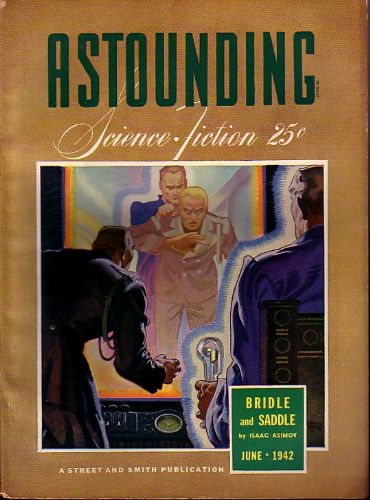
“Proof”, a 1942 short story by Hal Clement, Astounding Science-Fiction, June 1942. I love the story by Clement about how he wrote and sold his first story. Probably first read “Proof” recently in “The Ascent of Wonder” (1994, Cramer/Hartwell); I suspect I first read it in the 1971 “Where Do We Go From Here?” anthology (Asimov editor, Doubleday). This is a very good first story that makes sense, of sun-based intelligences and the loss of a ship to an inexplicable phenomenon of low temperatures and density. of course, that inexplicable phenomenon is the Earth, with a geologist witnessing the ship’s cataclysmic end. I rated this 3.8/5.

“Loophole“, a short story by Arthur C. Clarke from Astounding Science Fiction, April 1946. A fun little introduction from “First Voyages” by Clarke about the story, which he notes was the first to be published but not the first to be sold. This shows up in “A Treasury of Science Fiction” (1948, Conklin) and “Expedition to Earth” (1953); I own and have read both, so I have read this before. Still, I remember nothing. Mars is worried after the technological progress of Earth and the warlike behavior at the end of WW2, with the atomic bombs and nascent rocket programs. Mars broadcasts an ultimatum, stating that cities will be destroyed if rockets are launched. The Earth acquiesces, surprisingly. This is all recounted as memos to/from parties in the Mars government. At the end, we see that all of these memos were from captured material, after the Earth teleported bombs to Mars, which was pursued after the Martian ultimatum. A good story, but not as good as his “Rescue Party”, which was sold first but not published first. Rated 3.5/5.
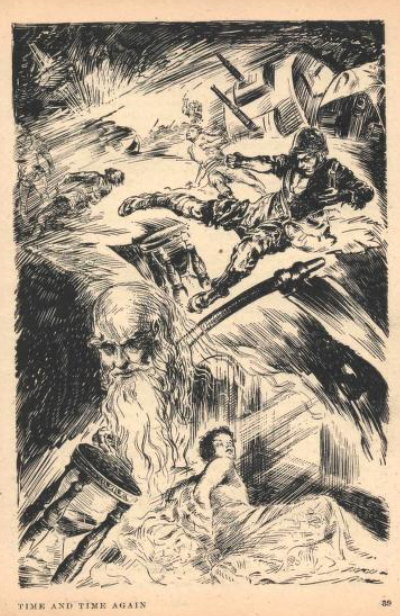
“Time and Time Again“, a short story by H. Beam Piper, from Astounding Science Fiction April 1947. This is a good first story by Piper. A man, fighting in World War III, is hit by a combination of a bomb and then a shot perhaps. His consciousness ends up back in his 13 year old body, right before the end of WW2. After doing a bit of thinking, he comes clean to his lawyer father. They develop a theory for how he was able to travel through time. They successfully change the world, and they set off to perhaps avert WW III. My biggest issue with the story is that the kind of hand-wave away what happens to his consciousness. Fun to reread this; I suspect I had read it only once, in Conklin’s “A Treasury of Science Fiction”. I rated this 3.5/5.
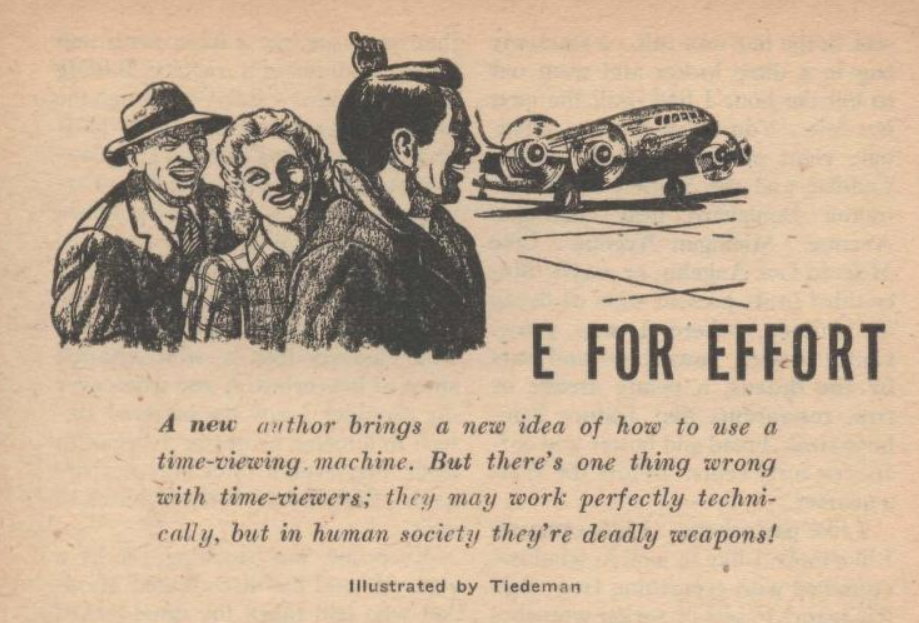
“E for Effort“, a 1947 novelette by T. L. Sherred, May 1947 Astounding. I don’t think I had read this story for decades. I had remembered liking it a lot, but could not remember any details. Wow! This is a great story, especially for 1947. Good, well developed characters, plot and dialog. My one issue is that I leave the end of the story not sure what happened in the end. Were they successful in sharing the info, or was the suppression successful? I lean to the machine being suppressed, but I am unsure, and perhaps that is on purpose by Sherred. I rated this 4.8/5.

“That Only A Mother“, a short story by Judith Merril in Astounding Science Fiction, June 1948. It’s a very good story. There is definitely foreshadowing that Maggie is not “normal” (whatever the hell that is). I think you could write this story today, but it would have to be told in a very different way to hold up. Rated 4.1/5.

“In Hiding“, Wilmar H. Shiras, a November 1948 Astounding novelette. Great story. Very matter of fact and unrolls slowly, with good characterization, of a genius young man, a mutant, and his first friend. This has held up very well. It is true that most of the action here is conversation, with some showing, etc. Rated 4.8/5.

“Defense Mechanism“, a short story by Katherine MacLean, in Astounding Science Fiction, October 1949. A very good story of what might happen, with the stipulation that many people are telepathic as babies but lose or are trained out of the ability. A good intro by MacLean in “First Voyages”. Rated 3.6/5.

“A Subway Named Mobius“, by A. J. Deutsch, Astounding December 1950. First read in Conklin’s “Omnibus of Science Fiction”. The first and only piece of fiction by this astronomer. A great story of a Boston subway, topology, infinite connectivity, multiple dimensions, timeslip, and a lost subway train. Heavily anthologized, including Conklin, “Best SF Four: Science fiction Stories” (Crispin), “Where Do We Go From Here?” (Asimov), and “The Great SF Stories 12 (1950)” (Asimov/Greenberg). Rated 3.8/5.

“Scanners Live in Vain“, a Instrumentality of Mankind novelette by Cordwainer Smith from Fantasy Book, Vol. 1, No. 6, January 1951. Disclosure: I am a really big Cordwainer Smith fan. I have read this story more than a few times, but I still caught things this time through that surprised me. One of my all time favorites. Cordwainer Smith certainly had a vision which he attempted to articulate in his works. His worlds and what happen there are very unique in some ways, and he does not throw out a lot of helping hands – you really have to read them closely and think about them. In theory it could have shown up in Galaxy in 1950, but the Wikipedia article notes that it had been rejected a number of times since being written in 1945. Rated 4.9/5.

“Angel’s Egg“, a novelette by Edgar Pangborn, Galaxy June 1951. Wow. Another amazing first published story, in a variation of the epistolary story in letters as a case file with the FBI, featuring correspondence and a journal of Dr. Bannerman. The doctor has been found dead by a friend. The doctor’s journal recounts his experiences with an “angel”, a member of a very advanced alien race. He sacrifices his self/memories to help the aliens learn how to help humans. It appears the story is filed and forgotten. In “First Voyages”, this come with a nice introduction by Pangborn’s sister, writer Mary Pangborn. This and other sources mention his long (21 years) career writing mystery stories under pseudonyms, when he was “learning to write by writing” before releasing his first story under his own name here for this story. Rated 3.9/5.

“Dune Roller“, a novelette by Julian May, December 1951 Astounding. Julian May first came to my attention as the author of “The Many-Colored Land” in 1981 (Houghton Mifflin). I thought this was a pretty darn good book, and went on the happily read more by May as time went on. It was only later than I realized I had read this story by her writing as “J. C. May” in Astounding, probably in 1970s. It looked like she stopped writing fiction from 1953 to 1981, although ISFDB does list some non-fiction for her in that time. Regardless, this is a very good story of a man, an academic ecologist, who lives alone in Michigan in the dunes near Lake Michigan, and likes it that way. At the start of the story, there is mention of a meteorite falling into Lake Michigan long ago. The ecologist begins to suspect there is an alien being in the area, a dune roller. He confirms this after a woman he comes to love is menaced by the roller for having a small drop of the roller’s substance on a pendant, a gift from him. He decides to take action. He destroys or disperses the roller into minute pieces, which begin to reunite again. We conclude that this dune roller was from the meteor. Although the basic idea of an alien invader via a meteorite is not at all novel, the execution is very well done, good characters. Reprinted in several Bleiler & Dikty 1950s anthologies, along with The Arbor House Treasury of Science Fiction Masterpieces (Greenberg/Silverberg), and The Great SF Stories #13 (1951) (Asimov/Greenberg). Rated 3.7/5.

“Come On, Wagon!”, a 1951 short story by Zenna Henderson in The Magazine of Fantasy and Science Fiction, December 1951. A nice intro by Henderson in “First Voyages”. A great story about what kids can do before they learn it is impossible. I rated this 3.7/5.

“Beyond Lies the Wub“, a Philip K. Dick short story, in the July 1952 Planet Stories. This is a very impressive first published story. A spaceman buys a creature that looks like a large pig, a wub. The wub turns out to be intelligent. The captain kills and eats it anyway. The wub personality/intelligence ends up in the captain, by empathy. There is a great intro by Dick in “First Voyages”. I rated this 3.7/5.
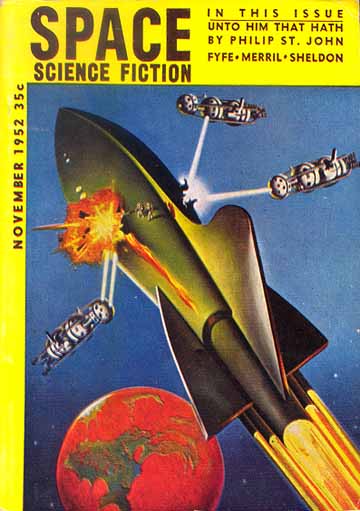
“Walk to the World“, a short story by Algis Budrys, in Space Science Fiction, November 1952 . A very good story about walking to the world, that Home is not the world, and duty, and perhaps a different outcome. The father is an ex-space navy officer, who feels that home is where you are going to. Good intro by Budrys in “First Voyages”. I rated this 3.7/5.
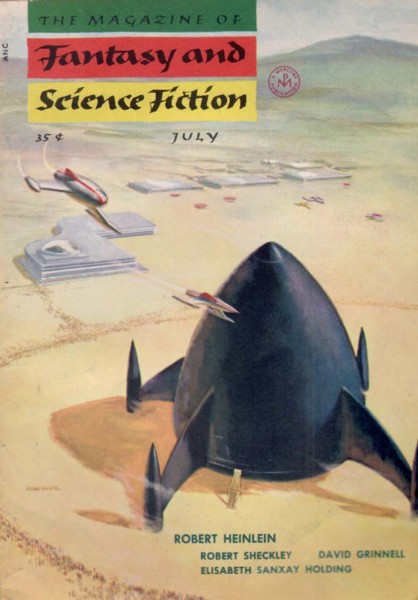
“My Boy Friend’s Name Is Jello“, a short story by Avram Davidson, in The Magazine of Fantasy and Science Fiction, July 1954. I rather like this story involving a man who is ill and a hand clapping game, but I struggle with what it is about. Great intro by Davidson in “First Voyages”. Rated 3.7/5.

“T” by Brian W. Aldiss. A 1956 short story by Brian W. Aldiss, Nebula Science Fiction, Number 18. This is a very interesting story with a definitive voice for a first written story by Aldiss. An ancient alien race is menaced by warlike Man. They send custom sentient beings in a fleet of 10 ships across time and space to eliminate the Earth and Man before Man emerges. They succeed in eliminating the planet, but fail due to a reality issue- to wit, they eliminate the wrong planet from the Solar system. Good intro by Aldiss in “First Voyages”; this was his first story sold, but did not appear for 3 years, so not first published. I rated this 3.9/5.

“Prima Belladonna”, a 1956 Vermilion Sands short story by J. G. Ballard, Science Fantasy, v 7 #20. Judith Merril notes this as the first published SF story by Ballard. It appears that he had two stories published in December 1956, so this could be the first. A great first story that kept me interested and yet off balance. A man in a very different Earth runs a music shop with plants that produce music. He meets and has an affair with a half-alien woman who sings as an entertainer, and sings with the plants in his shop. She cheats at i-Go, and she disappears. “First Voyages” has a very interesting and insightful intro by Ballard, who notes that this is both his first short story and also in some ways his best. I rated this 3.9/5.

“Turn off the Sky”, a Ray Nelson, novelette, The Magazine of Fantasy and Science Fiction, August 1963. Quite an impressive first published story. A lot of influences of beatniks and proto hippies, and quite a wild ride. A nonviolent anarchist falls in love with one of the few remaining capitalists (a sex worker) in a post-scarcity world. Great characters, and a nomination below cutoff for the 1964 Hugo. I need to read more Ray Nelson. Rated 3.9/5.

“Anita“, a Keith Roberts short story, Science Fantasy, September-October 1964. Anita loses a friend to human stupidity, and she manifests her powers for the first time accordingly. I know this is a fantasy story about a witch, but I’m including it anyway. I rated this 3.5.

“Traveler’s Rest“, a David I. Masson 1965 short story, New Worlds SF, September 1965. I am very impressed by David Masson’s first story. It’s an enjoyable story of a man at the front of a hard to understand war, where time passes faster and faster as you approach the front. He is given leave to return to civilian life, way down gradient. He lives a rather long life with a family before he is redrafted back to the front, arriving only minutes after he left. He wonders at the unknown nature of the enemy, who are perhaps themselves across some kind of mirror or time singularity. Christopher Priest’s “Inverted World” might have been influenced by this story. A great discovery for me. Both Wollheim/Carr and Merril Best Of’s included it. Rated 3.9/5.

“Bircher“, a novelette by A. A. Walde (Warren Bertil Lindgren), If, July 1966. I first read this in World’s Best SF 1967, by Terry Carr & Donald Wolheim (Ace). Wow. Great, great story, rather implacable and matter of fact. I never did figure out why the protagonist (a detective of some kind) hated himself, but I do suspect he was a reformed antisocial or criminal perhaps. The style reminded me a bit of Mickey Spillane. After a fairly involved search and research, I was able to confirm with his nephew that this is Walde’s only published story, written to prove the point that he could do so and sell it. I rated 4.4/5. I regret he did not write any more, as this showed real promise and was a very legitimate pick for the Carr/Wollheim World’s Best.
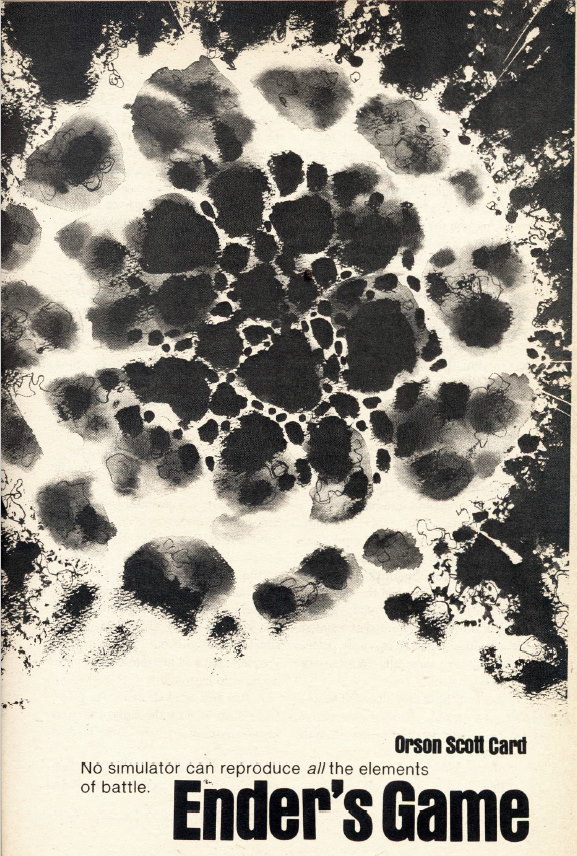
“Ender’s Game“, Orson Scott Card, a novelette from Analog August 1977. A great story, a classic for me. Children and a child war genius are manipulated into destroying the enemy of the human race by being told that they are still in training even though he is actually commanding the human fleet. I am sure I read the novel in 1985 or so, but might not have read the original novelette until I read “Visions of Wonder” in 1999. It is possible I read it in the 1984 “There Will Be War” anthology by John F. Carr & Jerry Pournelle. Hugo runner-up to Joan D. Vinge’s “Eyes of Amber”. I think I prefer the novelette to the novel. Rated 4.4/5.

“Antiquities“, a short story by John Crowley, first appeared in the anthology Whispers: An Anthology of Fantasy and Horror (August 1977, Doubleday), edited by Stuart David Schiff. A well wrought story recounted at a gentleman’s club in the classic vein of the “traveler’s tale”, of a plague of inconstancy, or men cheating on their wives, in the farmlands of England. A succubus or similar being is suggested, and a possible connection to 300,000 mummified Egyptian cats used for fertilizer in England mentioned. I know this is not SF, but I liked it anyway. I rated this 3.5/5.
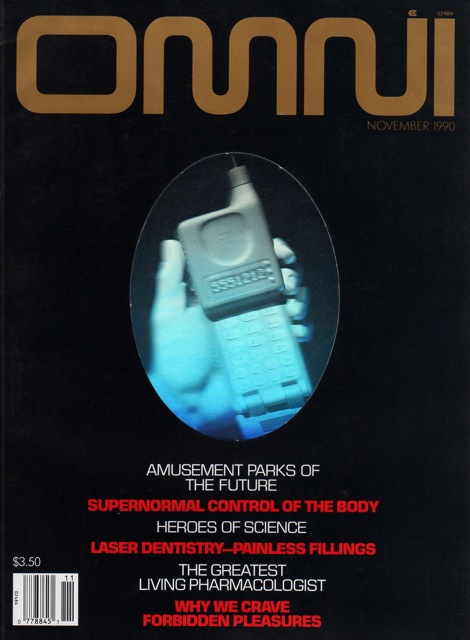
“Tower of Babylon”, Ted Chiang, Omni November 1990. wow. Quite an astounding first story, Nebula winner, Hugo #3, Locus #4, Dozois Year’s Best. The story of an Elamite miner sent as a crew of miners to mine through the vault of heaven at the top of the Tower of Babylon. The miners break through; the protagonist barely survives a flood as if from a reservoir, and finds himself in the desert some distance from Babylon. He reaches a conclusion how the world is formed, and resolves to share it. I know I read this in “Stories of Your Life and Others”, and perhaps in the Dozois Year’s Best. I rated this 4.3/5.
Leave a comment